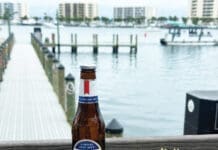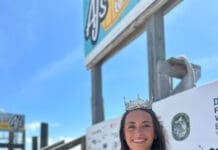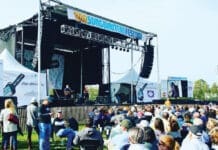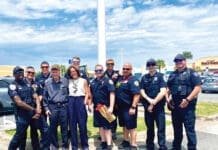By Brian L. Underwood, CBEP Executive Director, and Lori Smith, Publisher
 One of our area’s most beautiful, coveted and useful resources has been experiencing significant challenges—ones that affect water quality, natural systems and benefits provided by our own Choctawhatchee Bay. And, whether you think about it or not, this massive body of water is woven into our everyday lives as we come and go…to work, to fish, to boat, to play, to receive goods, to experience magnificent views, nature and wildlife, and the list goes on.
One of our area’s most beautiful, coveted and useful resources has been experiencing significant challenges—ones that affect water quality, natural systems and benefits provided by our own Choctawhatchee Bay. And, whether you think about it or not, this massive body of water is woven into our everyday lives as we come and go…to work, to fish, to boat, to play, to receive goods, to experience magnificent views, nature and wildlife, and the list goes on.
A defining characteristic of the coastal reaches of the Choctawhatchee River and Bay watershed has been growth and development in our region. Our population has increased significantly over the last several decades with a projected 21.24 percent growth over the next 20 years. Some of the greatest growth is in Okaloosa, Walton, Santa Rosa and Bay counties, which will bring continuing changes in land use and increasing demands on wastewater and stormwater management systems. (source: 850 Business)
 Encompassing more than 5,000 square miles, the Choctawhatchee Bay watershed extends through six counties in Northwest Florida and 10 counties in Alabama. Within our region, the contributions from this natural environment to our economy and quality of life cannot be overstated. Ecologically diverse, the watershed, land areas that drain into the Bay, includes one of Florida’s largest alluvial rivers, an expansive riverine floodplain, a 129-square mile estuary, tidal marshes and seagrass beds as well as coastal dune lakes, Floridan aquifer springs, barrier islands and longleaf-wiregrass forests. It also includes some of Northwest Florida’s fastest growing communities, including ours, as well as extensive public and private conservation lands.
Encompassing more than 5,000 square miles, the Choctawhatchee Bay watershed extends through six counties in Northwest Florida and 10 counties in Alabama. Within our region, the contributions from this natural environment to our economy and quality of life cannot be overstated. Ecologically diverse, the watershed, land areas that drain into the Bay, includes one of Florida’s largest alluvial rivers, an expansive riverine floodplain, a 129-square mile estuary, tidal marshes and seagrass beds as well as coastal dune lakes, Floridan aquifer springs, barrier islands and longleaf-wiregrass forests. It also includes some of Northwest Florida’s fastest growing communities, including ours, as well as extensive public and private conservation lands.
 The water resources that comprise the Choctawhatchee River and Bay provide numerous functions critical to our quality of life. The watershed’s wetlands and floodplains store and regulate stormwater runoff, protecting water quality, providing flood protection, and recharging aquifers and potable water supplies. Its lakes, streams and coastal waters sustain numerous species of fish, shellfish and wildlife. Its springs provide windows to the aquifer, and its wetlands and coastal barriers provide resiliency against storms and coastal change.
The water resources that comprise the Choctawhatchee River and Bay provide numerous functions critical to our quality of life. The watershed’s wetlands and floodplains store and regulate stormwater runoff, protecting water quality, providing flood protection, and recharging aquifers and potable water supplies. Its lakes, streams and coastal waters sustain numerous species of fish, shellfish and wildlife. Its springs provide windows to the aquifer, and its wetlands and coastal barriers provide resiliency against storms and coastal change.
To help preserve the Bay qualities we hold dear, the Choctawhatchee Bay Estuary Program (CBEP) was recently established as a community-based, non-regulatory organization to coordinate stewardship initiatives for the Choctawhatchee Bay and its watershed, aspiring to protect and enhance these valuable assets for our enjoyment and benefit. These include restoring water quality, restoring and conserving its habitat, replenishing and protecting living coastal and marine resources, enhancing community resilience and revitalizing our diverse coastal economy. Grants and funds raised allow groups who have long worked on these assets to coordinate their efforts, educate, steward, strengthen and maintain this vibrant contribution to our economy.
 In 2019, the Choctawhatchee Bay Estuary Program was the beneficiary of grant funding from The Nature Conservancy. Additional Program funds have been received through a federal RESTORE Act financial assistance award to the Gulf Consortium and Okaloosa County, on behalf of the Estuary Program, consistent with criteria set out in the RESTORE Act at 33 U.S.C. 1321(t)(3)(B)(i). Governance is provided by the Choctawhatchee Bay Estuary Coalition Board of Directors, represented by County Commissioners from Okaloosa, Walton, Holmes and Washington Counties in Florida. Other organizations represented on the Board include the State of Alabama’s Choctawhatchee, Pea and Yellow Rivers Watershed Management Authority, the Choctawhatchee Basin Alliance and Eglin Air Force Base as an ex-officio participant.
In 2019, the Choctawhatchee Bay Estuary Program was the beneficiary of grant funding from The Nature Conservancy. Additional Program funds have been received through a federal RESTORE Act financial assistance award to the Gulf Consortium and Okaloosa County, on behalf of the Estuary Program, consistent with criteria set out in the RESTORE Act at 33 U.S.C. 1321(t)(3)(B)(i). Governance is provided by the Choctawhatchee Bay Estuary Coalition Board of Directors, represented by County Commissioners from Okaloosa, Walton, Holmes and Washington Counties in Florida. Other organizations represented on the Board include the State of Alabama’s Choctawhatchee, Pea and Yellow Rivers Watershed Management Authority, the Choctawhatchee Basin Alliance and Eglin Air Force Base as an ex-officio participant.
A Comprehensive Conservation and Management Plan (CCMP) is currently being drafted for the Choctawhatchee Bay, River and headwaters. Consistent with the U.S. EPA’s National Estuary Program standards, the Choctawhatchee’s CCMP will highlight priority resource groups along with strategies to mitigate many of the known challenges. Some of these strategies include best practices for community resilience, water quality protection, natural resources management and land use planning.
Initial planning strategies have been successful, yielding positive stakeholder engagement. Reflecting the National Estuary Program model, the Choctawhatchee program has organized technical advisory, education and outreach committees comprised of regional partners, who provide local knowledge and information on watershed issues. “We are hoping to build our partnerships to include a Community Advisory Committee and a Business and Industry Committee comprised of business owners, land owners or other members of the community interested in becoming involved in the Estuary Program and the CCMP development,” says Chelsea Conley, CBEP Outreach Specialist.
If you would like to learn more about the Choctawhatchee Bay Estuary Program, visit MyOkaloosa.com/cbec/program_overview.html or Facebook.com/ChoctawhatcheeBayEstuaryProgram. For additional information, contact Chelsea Conley, Outreach Specialist, at 850-609-5390 or cconley@myokaloosa.com.





























































